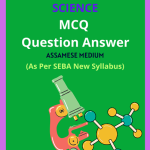Class 8 Science MCQ Chapter 14 Chemical Effects Of Electric Current Solutions in English Medium, Class 8 Science Multiple Choice Question Answer in English to each chapter is provided in the list so that you can easily browse throughout different chapters Class 8 Science MCQ Chapter 14 Chemical Effects Of Electric Current Notes and select need one.
Class 8 Science MCQ Chapter 14 Chemical Effects Of Electric Current
Also, you can read the SCERT book online in these sections Class 8 Science Objective Type Solutions by Expert Teachers as per SCERT (CBSE) Book guidelines. These solutions are part of SCERT All Subject Solutions. Here we have given Assam Class 8 Science MCQs Solutions in English for All Subject, You can practice these here.
Chemical Effects Of Electric Current
Chapter – 14
| MCQ |
1. Which of the following is a bad conductor of electricity?
(a) Distilled water.
(b) Silver nitrate.
(c) Sulphuric acid.
(d) Copper sulphate.
Ans: (a) Distilled water.
2. Which of the following does not conduct electricity?
(a) Sugar solution.
(b) Vinegar solution.
(c) Lemon juice solution.
(d) Caustic soda solution.
Ans: (a) Sugar solution.
3. An electric current can produce.
(a) Heating effect.
(b) Chemical effect.
(c) Magnetic effect.
(d) all of these.
Ans: (d) all of these.
4. Pure or distilled water is a:
(a) Poor conductor.
(b) Good conductor.
(c) Both (a) and (b).
(d) None of these.
Ans: (a) poor conductor.
5. Which of the following is a good conductor?
(a) Brick.
(b) Steel.
(c) Plastic.
(d) Cotton.
Ans: (b) Steel.
6. Polythene is:
(a) a conductor.
(b) An insulator.
(c) Both (a) and (b).
(d) None of these.
Ans: (b) an insulator.
7. Electroplating is based on.
(a) Heating effect of electricity.
(b) Chemical effect of electricity.
(c) Physical effect of electricity.
(d) Magnetic effect of electricity.
Ans: (b) Chemical effect of electricity.
8. Copper is.
(a) a good conductor.
(b) an insulator.
(c) both (a) and (b).
(d) none of these.
Ans: (a) a good conductor.
9. Waste from an electroplating factory must be disposed off:
(a) In the nearby river.
(b) In the nearby pond.
(c) In the nearby cornfield.
(d) According to the disposal guidelines of Waste Management Bodies.
Ans: (d) according to the disposal guidelines of Waste Management Bodies.
10. An electrolyte is:
(a) a metal.
(b) a liquid that conducts current.
(c) a non-metal.
(d) none of these.
Ans: (b) a liquid that conducts current.
11. Flow of electron is called:
(a) electrolyte.
(b) Electroplating.
(c) Electrodes.
(d) Electric current.
Ans: (d) electric current.
12. Which is not a nonelectrolyte?
(a) Ethyl alcohol.
(b) Sodium chloride.
(c) Urea.
(d) Sodium solution.
Ans: (b) Sodium chloride.
13. An electric lamp glows due to:
(a) Heating effect.
(b) Magnetic effect.
(c) Chemical effect.
(d) Physical effect.
Answer: (a) heating effect.
14. Electroplating prevents.
(a) Corrosion.
(b) Passing of current.
(c) Dissociation.
(d) Shining.
Ans: (a) corrosion.
15. Which of the following is not used for electroplating metal articles?
(a) Nickel.
(b) Silver.
(c) Chromium.
(d) Sodium.
Ans: (d) Sodium.

Hi! my Name is Parimal Roy. I have completed my Bachelor’s degree in Philosophy (B.A.) from Silapathar General College. Currently, I am working as an HR Manager at Dev Library. It is a website that provides study materials for students from Class 3 to 12, including SCERT and NCERT notes. It also offers resources for BA, B.Com, B.Sc, and Computer Science, along with postgraduate notes. Besides study materials, the website has novels, eBooks, health and finance articles, biographies, quotes, and more.




